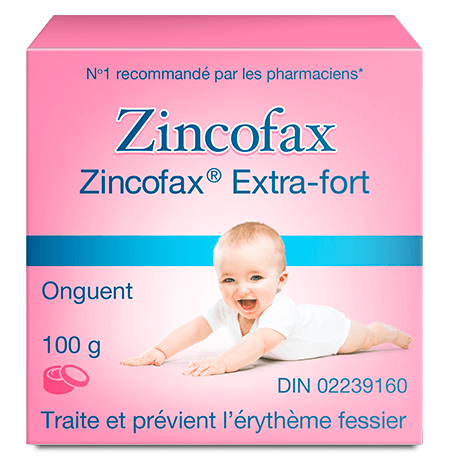How to deal with diaper rash
As a parent, you are probably worried that your crying child's skin is red, irritated and sore. How did this happen? How can you relieve it? How can we prevent it? These are three questions that parent asks themselves at least once in their lives. Familiprix, Zincofax and Vie de Prents offer you the answers.
What is diaper rash?
It is a rash that is triggered when a baby's skin is irritated by wet or soiled diapers. It's called "dermatitis." This inflammation of the skin on the buttocks and genitals causes redness and flaking. Because the baby's urine is alkaline, it creates an environment for bacteria in the baby's stool to become active. If the child has very sensitive skin or if the urine or stool in the diaper remains in contact with the skin for too long, these bacteria produce enzymes that break down the epidermal barrier, leading to diaper rash. Diaper rash can also occur during or after a period of diarrhea, digestion of new food, or increased body heat in a tight diaper.
The alkaline environment can also lead to the development of a more severe infection called candidiasis.
What is candidiasis?
Candidiasis is a yeast infection caused by candida albicans, an organism that usually lives on our skin, in our mouth and in our intestines. Sometimes, the yeast multiplies uncontrollably and causes pain and inflammation. Candidiasis can appear on the skin and genitals. It is also a common cause of diaper rash. The infection creates patches of red skin, itching, scabs and pustules. You should consult a healthcare professional who will recommend an antifungal medication.
What are the symptoms of diaper rash?
Redness, itching, small red bumps and shiny areas in the diaper area (buttocks, upper thighs and genitals) are the first signs of diaper rash. You may also notice that the skin is hot, and that the child tends to scratch and cry when changing diapers. Diaper rash can get worse and turn into an infection. In this case, small red bumps will appear in the skin folds. Blisters, pus and very swollen red areas may also occur. A healthcare professional should be consulted to prescribe appropriate treatment.
How you can prevent diaper rash
- Change your child's diaper often, especially if they have diarrhea.
- Clean the buttock area well with non-scented soapy water or non-scented wipes; make sure the area is properly dry.
- Apply an unscented protective cream, such as Zincofax®, to protect the skin from moisture.
- Avoid sharing the cream with other children.
- Do not put the same finger back in the jar after touching the irritated skin.
- Make sure that washable diapers are dry.
- Avoid tight or airtight plastic diapers that prevent air from circulating. Friction between the diaper and the skin folds can also cause diaper rash.
- Avoid using talc or cornstarch, especially during a severe diaper rash. Talc can even enter your baby's lungs, and cornstarch can cause a yeast infection.
How you can help alleviate the symptoms of diaper rash
- Wash the buttocks with lukewarm water (or a little mild soap if there is stool). Never use scented soap or wipes. If the skin is very irritated, a warm water bath will soothe your child's pain and allow you to clean the affected area gently.
- Pat the diaper area dry.
- Apply a generous layer of zinc oxide ointment, such as Zincofax®, as it protects the skin from moisture and promotes healing. Note that these products may not be suitable for your child. Always read the label and follow directions. For external use only.
- Leave the child bare-bottomed as much as possible to expose the skin to the air. This will help the diaper rash heal more quickly.
Zincofax® cream and its properties

To help or protect your baby from diaper rash, Zincofax® cream is a must. Apply a thin layer to create a protective barrier in irritated or sensitive areas. As a preventive measure, you can apply it during diaper changes; it’s a great way to remember.
Some hygiene tips:
Avoid sharing jars or tubes. Ideally, identify each jar or tube with a child’s name.
As for handling, it is important not to contaminate the irritated skin by double contact, so if you apply the cream with a finger and need an additional layer, it is preferable to change fingers.
In addition, you can consult the Zincofax® treatment and prevention guide. Always read the label and follow directions. For external use only.
Diaper rash overview
Seven (7)
Seven to twelve months is the age when diaper rash most often occurs. In fact, it can start from birth all the way through potty training.
Four (4)
If the inflammation does not go away within four days of starting treatment, a healthcare professional should be consulted. They will prescribe further treatment until the problem is resolved.
1945
1945 was the year that the brand Zincofax® was introduced. It has been recommended by pharmacists and used by parents for generations.
Sources
Pharmacy Practice + Business et Profession Santé, 2021
https://mariefortier.com/postnatal/diaper-rash?lang=en
https://www.noovomoi.ca/vivre/sante/article.erytheme-fessier.1.1303983.html (french only)
https://caringforkids.cps.ca/handouts/pregnancy-and-babies/diaper_rash
https://www.canada.ca/en/health-canada/services/consumer-product-safety/reports-publications/industry-professionals/product-assessment-against-criteria-diaper-rash-products.html
